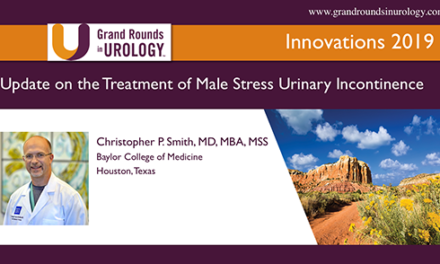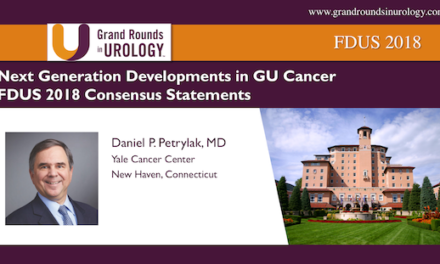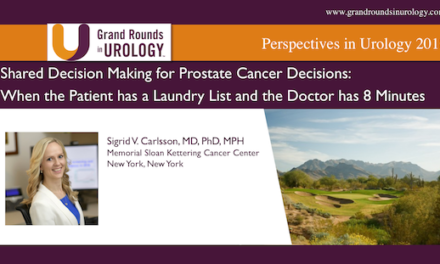Dr. Jehonathan Pinthus presented “Treatment of Invasive Bladder Cancer in the Elderly and Frail Patient ” at the International Bladder Cancer Update meeting on Tuesday, January 24, 2017.
Keywords: bladder cancer, BCG, CIS, chemotherapy, cystectomy, elderly, invasive, neoadjuvant, nonagenarians, TURBT
How to cite: Pinthus, Jehonathan. “Treatment of Invasive Bladder Cancer in the Elderly and Frail Patient ” January 24, 2017. Accessed Jan 2025. https://dev.grandroundsinurology.com/treatment-invasive-bladder-cancer-elderly-frail-patient
Transcript:
Treatment of Invasive Bladder Cancer in the Elderly and Frail Patient
I think this is a very contemporary topic because we are living in an aging society. If you look here, and you know if you really want to look at the life expectancy you should look at charts of the insurance company and governmental agencies rather than medical reports. And this is the life expectancy nowadays where in North America. So, you can see that if you are at the octogenarians, octogenarians for the sake of this talk is 80 years old, 80 to 90, and nonagenarians are 90 and plus. And you see so when you hit 80 you still have at least seven years as a male, and nine years or more as a female. So, we are actually talking about increased population that, and I’ll show you data, has more bladder cancer, and they’re actually destined to live quite long if they are in the average risk. So, if you live for example to 90 years old you’re expected to live about four years if you’re a male and four and a half or five years if you’re a female. So, we have to bear these figures in mind.
And the probability of developing a muscle invasive bladder cancer increases with age. So, currently in the United States the median, not even the mean, age of diagnosis is 73 years old. And as we grow up we see that the number catches up and significantly in males over the age of 70. So, it’s a very common phenomenon, and indeed this is data from our multidisciplinary bladder cancer clinic. You can see that the third at least of the patients are nona and octogenarians, and those are coming to a tertiary center to get an opinion regarding, and even takeover obviously, of therapy in their specific situation.
Why is bladder cancer, or muscle invasive bladder cancer, so common in elderly patients? So, it may be that it’s a more aggressive superficial disease. There’s certainly an element of delaying diagnosis, and probably some different biology. In terms of more aggressive superficial bladder cancer there is plenty of papers about that. This is just one that is very interesting looking at the differences in terms of progression and recurrence in patients that received, that had non-muscle invasive bladder cancer. They received TURBT and intravesical BCG, and one can see that age was an independent risk factor for tumor recurrence and progression. Essentially recurrence was 2.3 times in patients over the age of 80, compared to younger patients. And this is another way to look at the data. You can see the significance, odds of recurring and progressing even despite the intravesical BCG and the TURBT in elderly patients.
Delaying diagnosis; this is very common unfortunately, and we see it more and more. This is data from Hollenbeck, and you can see that it’s not uncommon to have a delay of diagnosis of even a year. And this is usually happening because of very precise characteristics. Okay? Granny has hematuria, she has some lower urinary tract symptoms, the GP puts a stick, a dipstick, obviously there will be white blood cells and red blood cells because it’s a tumor there, and they prescribe her with antibiotics and there is no urine culture, nothing. So, the common complaint is that I had urinary infection for a year until they found it. No, and I insist that if you do have, if you call something a urinary tract infection show me the urine culture, show me that there was a bacteria that caused things, and I see it a lot, a lot, a lot in my clinic. So, there is certainly delay in diagnosis.
But once it’s diagnosed we have a very poor, we poorly address that. This is a paper by Gore et al, and it shows that only 21% of muscle invasive bladder cancer patients over the age of 65 here actually received radical cystectomy. He shows also that there was a better overall survival, but obviously this is biased by selection.
But if you look here at another study that looked at the National Cancer Database you can see that the older you are the less chance that you will receive treatment. indeed, half of the patients that are over age 80, I’m sorry 85, received any type of therapy for their muscle invasive bladder cancer, not to speak about cystectomy, which is the very bold gray there.
The natural history of muscle invasive bladder cancer, so why is it okay to leave it untreated in someone who is 85? Well, I think most of us in this room will agree that if left untreated most patients with muscle invasive bladder cancer will have significant morbidity, and will die from the disease within two years of diagnosis. So, a life expectancy of two years has been suggested to be a benchmark to consider radical cystectomy. So, you can’t just not treat it if someone is destined to live five, six, eight, or nine years from, even if they’re elderly. Again, this is reflected here.
The perception would be well, those are elderly patients, they will not tolerate radical cystectomy, and urinary diversion because they’re A, because of their age, frailty, other comorbidities. And what we do is we usually eyeball that, but that’s wrong, and we need to get over that and incorporate tools that have been suggested by for example the geriatric society to better risk stratify patients for, cancer patients for major cancer surgeries. And you can see that age can be only a chronological marker and not necessarily a functional marker, and there are many tests and many algorithms that we do not use frankly as urologists, as medical oncologists potentially, as radiation oncologists, we don’t use them. For example, how many of you do use the activity of daily living, the instrumental activity of daily living, the Geriatric Depression Scale for example, to assess when you come to decide whether to do a radical cystectomy on an elderly patient. And these scales have been shown to be associated with 30 days of mortality. I guess few of us do it because are not aware of that or we’re just ignoring it.
And behind the risk assessment, behind getting a number, I think it’s very important, and it’s not really a nursing talk, but really, really have to be very conscientious of these two elements. First of all, we have to balance a discussion about quality of life because this is very, very important in this age population. But also, for example, looking if there is an effective caregiver. Why? Because an effective caregiver can prevent the transformation of disability to a handicap. If you have an ileal conduit and you don’t have any caregiver that can take care of that you’re handicapped. You’re not disabled. And this is very, very important.
Radical cystectomy for elderly patients most of the serious I have to say, I mean obviously they are retrospective and they are quite old, but you can see that if you compare extirpative surgery and other treatment modalities that has the best cancer-specific survival, at least according to these studies and other studies. This is the SEER data of about 11,000 consecutive patients with muscle invasive bladder cancer. About 8,000 of them underwent radical cystectomy, and close to 3,000 had the bladder preservation and that had to include radiation therapy. They excluded a patient that had, they had no data on stage, grade, CIS, PT1, etcetera. And what you can see that the overall survival surpassed and was significantly more in patients at all ages with a bladder cancer, including octogenarians. Cancer-specific survival followed the same, and in fact a patient who had radical cystectomy had better cancer-specific survival regardless of age if node-positive cases were excluded for octogenarians.
This is a summary of several literatures that are, of the literature that is out there, and you can see generally, and the definition is usually octogenarian, so patients over the age of 80, and you can see that you can, one can achieve an overall survival in five years of about a third, so 35% overall survival, and cancer-specific survival of around 40 to 45%. And again, this is something that may be important to patients that are destined to live another five years.
We have to acknowledge though that octogenarians that undergo radical cystectomy are often found with a more aggressive disease. Now, we in our clinic, in our multidisciplinary clinic, tend not to recommend often neoadjuvant chemotherapy for octogenarian and nonagenarians. I will be interested to discuss that potentially with the forum, but the idea is that the studies that showed the benefit for neoadjuvant chemotherapy using translates to five years from the neoadjuvant chemotherapy. So, if your expected survival would be five years I’m not sure that the 5% of advantage of survival within five years justifies the morbidity of neoadjuvant chemotherapy. But bear in mind that octogenarians and nonagenarians will have a more aggressive disease on pathology.
Radical cystectomy in muscle invasive bladder cancer in the octogenarians, and obviously in the nonagenarians, is associated with high survival rates compared to other treatment strategies. This is suggested by a retrospective analysis, which is obviously biased. And the T stage is typically more advanced. The question is is it safe? This is the most – – study from Memorial Sloan Kettering by Harry Herr and Machele Donat. They looked in almost 1,200 patients that underwent radial cystectomy at Memorial, and compared between patients that were older than 80 and younger than 80. And what they found essentially is that there was no significant change in the rate of minor or major complications after treatment after they adjusted to baseline characteristics. But please pay attention. There was higher overall, a 90-day mortality rate of about 6.8%/7.0%. So, most studies reported that radical cystectomy is safe in the octogenarians and the overall mortality is 4%, however this increased up to 10% in 90-day mortality. But actually, all of these studies are retrospective in a highly selected population. But we have to recall, and if you think of the alternative is that death by untreated bladder cancer is much more common than death related to the intercurrent and medical diseases, and the quality of life during this survival time is strongly affected. So, we have to do something.
What are the other alternative options? Well, let’s talk about potential TURBT only, bladder sparing, radiation therapy, and omitting the diversion. So, TURBT only, this is the Solsona famous paper looking at very highly selective patient population. They had to be patients with no T3 disease, so T2 only. He excluded tumors that were over 3 centimeters, no patients with hydronephrosis, and obviously with lymphadenopathy. He did include patients with multifocal disease and CIS. And this is a 15-year follow up, and what you can see that in these very highly selected patients, and you add to the selection because you have to have negative biopsies, at least five of them of the tumor bed after you complete the TURBT, but in very highly selected patients say 85 with a tumor size of less than 3 cm that you can achieve that, perhaps you’re doing the best thing because you can get a five-year survival of 70% as you can see there.
Partial cystectomy; there is very few data, none in octogenarian. This is just a series from Wes Kassouf, so I will omit that because we really don’t have enough data.
Bladder sparing; so we get this often to our multidisciplinary bladder cancer clinic, can you do bladder sparing for that? Well, we know that there are issues with eligibility, and we can relate it to oncological. A high proportion of octogenarian patients do have locally advanced disease, hydronephrosis and so forth. They’re obviously not fitted.
Radiation, if someone has significant incontinence, a very small capacity bladder just from aging that can cause some significant side effect. Salvage radical cystectomy if you fail will be hard, but most importantly I think is the ability to tolerate the cisplatin. And if you’re a believer that you have to have a GFR, or creatinine clearance of over 60 mL/min then we know that only 60% or so of the elderly would have it. So, what I think is that if your patient can really not tolerate radical cystectomy what are the really odds that they can get the full package of bladder sparing? I think quite low, and we do have some, we didn’t publish that, but data from our own bladder cancer clinic.
Yes, you don’t have to give certainly cisplatin chemotherapy in combination with a bladder preservation. This is a very nice study from England. It was published I believe two years ago in the New England Journal of Medicine. Here they used 5FU and mitomycin C and combined with radiation. They had to have a GFR of over 25, which is a significant discount, and they could see that the five-year overall survival was about 48% for the chemo/radiation arm. So, I think it’s quite reasonable if someone has a five-year survival, or sorry five years life expectancy expected. This is something to consider.
With respect to the diversion I missed here in the slides, but we know that the majority of the morbidity from radical cystectomy actually relates to the bowel part of the surgery. And it happened to me that if there are patients that really need the radical cystectomy, for example for a solve of significant bleeding, significant disease but they had previous abdominal operations and they already have nephrostomies often times I would make with them a deal. I would say let’s go and do a proper radical cystectomy, lymph node dissection, which I omitted here in the talk, but we do have to give the same lymph node dissection to our octogenarian patient, and have you with two nephrostomies. And I think this is a very compromise, and I can tell you from my limited experience they recover from that very well.
To wrap up, the take-home message I think is that muscle invasive bladder cancer is common in octogenarians. Special attention should be paid to early detection, so don’t accept just a title of UTI or so forth, you have to investigate that. Recurrence and progression of non-muscle invasive bladder cancer are more common in octogenarians. Compared to other treatment radical cystectomy seems to result in the best oncological outcome in octogenarians with muscle invasive bladder cancer. Again, this is not prospective data.
The risk of complication in radical cystectomy in elderly men is influenced by medical conditions rather than the chronological age. And we do have geriatric tools, and we do have other tools that can better risk stratify the risk. So, we cannot just eyeball them and exclude them from surgery. Radical cystectomy can be done safely in octogenarians. I think, and this is something that we did obviously, we assembled a good support team, so it’s more than the surgeon I think. It’s the support team, cardiologists, ICU, geriatrician, nutritionist, occupational therapists, social worker, and so forth, because we have not only to get them through the surgery but rather have them living a decent quality of life after surgery. The option of radical cystectomy should not be withheld from appropriately selected octogenarian, but this is a very balanced talk, and ultimately after you present everything you have to obviously prospect and understand the patient perspective because he or she are older than you. Thank you.
ABOUT THE AUTHOR
Dr. Pinthus is an Associate Professor in the Department of Surgery’s Division of Urology at McMaster University in Hamilton, Ontario. He is a surgical oncologist-urologist who completed his MD at the Hebrew University in Jerusalem, Israel, and his urology training at the Sheba Medical Centre at Tel Aviv University in Israel. He then completed 2.5 years of an SUO-accredited Fellowship in Uro-Oncology at the University of Toronto. Dr. Pinthus earned his PhD at the Weizmann Institute of Science in Rehovot, Israel, working on gene immunotherapy of prostate cancer.
He is heading a basic and translational research laboratory at McMaster University and his research interests relate to how patients’ individual host factors and metabolism affect prostate cancer growth and response to therapy. Dr. Pinthus has published more than 80 peer-reviewed papers and several book chapters. He is a member of the editorial board of European Urology, Prostate Cancer, and Prostatic Disease. Dr. Pinthus is the principal investigator on many distinguished research grants, including a $3.5 million Movember-Prostate Cancer Canada grant titled “Role of androgen deprivation therapy in cardiovascular disease - a longitudinal prostate cancer study (RADICAL PC).” This study is intended to prospectively address the potential link between prostate cancer in general and androgen deprivation therapy (ADT) in particular and an increased risk of cardiovascular disease.





